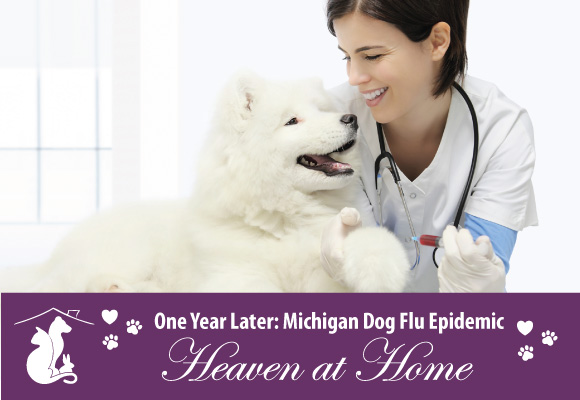
By this time last summer, Michigan was amidst a rapid spread of Canine Influenza, three years after an outbreak of new strain H3N2 in Chicago. In Grand Rapids, some doggie daycares closed and mounted mass vaccination efforts while pet parents sidelined social opportunities for 10-30 days to confine the spread. Meanwhile, confirmed cases of CIV spread across the US, with approximately 20% of affected pets contracting the severe, life-threatening form.
What can we expect this year?
“It will depend on how many pet parents vaccinated their pets. This is a new strain of avian origin so pets who’ve not previously been exposed are at risk. There’s no natural immunity to Dog Flu,” said Dr. Laurie Brush, founder of Heaven At Home Pet Hospice.
In her line of palliative work, “Dog Flu” is a serious — and possibly deadly –complication for senior pets who have other health ailments and compromised immune systems. In these companion animals, fevers can range from 104ºF to 106ºF and may show clinical signs of pneumonia, such as increased respiratory rates and effort.
“Vaccination should be considered for dogs with heart or respiratory conditions, dogs that travel or show, and those that have extensive contact with other dogs,” she said.
Signs of Dog Flu to Watch for:
“Dog Flu” symptoms are very similar to Bordetella and other viruses. Testing is tricky because there is a 3-day window for active testing before antibodies are produced. Watch your pet for these signs:
- High Fever (103ºF)
- Loss of appetite
- Cough, which may be dry or may bring up sputum
- Runny nose with clear secretions at first, but may later change to thick yellow or pink-tinged color
How does it Spread?
Dogs who are boarded, go to daycare or visit grooming facilities where there is close contact with other dogs are at highest risk. The virus spreads through direct contact, through the air from a cough or sneeze, and from contaminated objects like water bowls or human hands. How to Prevent Dog Flu Vaccines are now available for both strains of CIV, and are given in a series of 2 shots 2-4 weeks apart. The vaccine may not all together prevent an infection, but will reduce the severity and duration of clinical illness.
